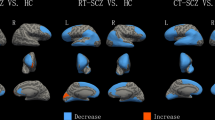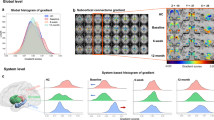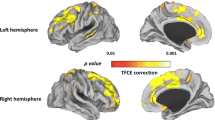Abstract
Decreased gray matter volume (GMV) in the superior temporal gyrus (STG) has been implicated in the neurophysiology of schizophrenia. However, it remains unclear whether volumetric reduction in the subregions of the STG can predict treatment efficacy for schizophrenia. Our cohort included 44 drug-naive, first-episode patients, 42 unaffected siblings and 44 healthy controls. Voxel-based morphometry and pattern classification were utilized to analyze the acquired imaging data as per the anatomical subdivision by a well-defined brainnetome atlas. The patients presented lower GMV values in left TE1.0/1.2 (TE, anterior temporal visual association area) than the siblings, and lower GMV values in the left/right TE1.0/1.2 and left A22r (rostral area 22) than the controls. A positive correlation is observed between the GMV values in the right A38l (lateral area 38) and baseline Positive and Negative Syndrome Scale (PANSS) total scores in the patients. Support vector regression (SVR) results exhibited a significant association between predicted (based on the GMV values in the right A38l) and actual symptomatic improvement based on the reduction ratio of the PANSS total scores (r = 0.498, p = 0.001). Our results suggest that normal structure in the right A38l of the STG may be an important factor indicative of the effects of antipsychotic drugs, which can be potentially used to monitor drug effects for first-episode patients at an early stage in clinical practice.



Similar content being viewed by others
References
Allen, P., Laroi, F., McGuire, P. K., & Aleman, A. (2008). The hallucinating brain: a review of structural and functional neuroimaging studies of hallucinations. Neuroscience & Biobehavioral Reviews, 32, 175–191.
Andreasen, N. C., Nopoulos, P., Magnotta, V., Pierson, R., Ziebell, S., & Ho, B. C. (2011). Progressive brain change in schizophrenia: a prospective longitudinal study of first-episode schizophrenia. Biological Psychiatry, 70, 672–679.
Arango, C., Rapado-Castro, M., Reig, S., Castro-Fornieles, J., Gonzalez-Pinto, A., Otero, S., et al. (2012). Progressive brain changes in children and adolescents with first-episode psychosis. Archives Of General Psychiatry, 69, 16–26.
Asami, T., Bouix, S., Whitford, T. J., Shenton, M. E., Salisbury, D. F., & McCarley, R. W. (2012). Longitudinal loss of gray matter volume in patients with first-episode schizophrenia: DARTEL automated analysis and ROI validation. Neuroimage, 59, 986–996.
Barta, P. E., Pearlson, G. D., Powers, R. E., Richards, S. S., & Tune, L. E. (1990). Auditory hallucinations and smaller superior temporal gyral volume in schizophrenia. The American Journal of Psychiatry, 147, 1457–1462.
Chang, C. C., Hsu, C. W., & Lin, C. J. (2000). The analysis of decomposition methods for support vector machines. IEEE Transactions on Neural Networks and Learning Systems, 11, 1003–1008.
DeLisi, L. E. (2008). The concept of progressive brain change in schizophrenia: implications for understanding schizophrenia. Schizophrenia Bulletin, 34, 312–321.
Ding, Y., Ou, Y., Pan, P., Shan, X., Chen, J., Liu, F., et al. (2019). Brain structural abnormalities as potential markers for detecting individuals with ultra-high risk for psychosis: A systematic review and meta-analysis. Schizophrenia Research, 209, 22–31.
Fan, L., Li, H., Zhuo, J., Zhang, Y., Wang, J., Chen, L., et al. (2016). The human brainnetome atlas: A new brain atlas based on connectional architecture. Cerebral Cortex, 26, 3508–3526.
First, M. B., Spitzer, R. L., Gibbon, M., & Williams, J. B. W. (1997). Structured Clinical Interview for DSM-IV Axis I Disorders (SCID). Washington, DC: American Psychiatric Press.
Goghari, V. M., Smith, G. N., Honer, W. G., Kopala, L. C., Thornton, A. E., Su, W., et al. (2013). Effects of eight weeks of atypical antipsychotic treatment on middle frontal thickness in drug-naive first-episode psychosis patients. Schizophrenia Research, 149, 149–155.
Goldman, A. L., Pezawas, L., Mattay, V. S., Fischl, B., Verchinski, B. A., Chen, Q., et al. (2009). Widespread reductions of cortical thickness in schizophrenia and spectrum disorders and evidence of heritability. Archives Of General Psychiatry, 66, 467–477.
Gong, Q., Lui, S., & Sweeney, J. A. (2016). A selective review of cerebral abnormalities in patients with first-episode schizophrenia before and after treatment. The American Journal of Psychiatry, 173, 232–243.
Gottesman, I. I., & Gould, T. D. (2003). The endophenotype concept in psychiatry: etymology and strategic intentions. The American Journal of Psychiatry, 160, 636–645.
Guo, W., Hu, M., Fan, X., Liu, F., Wu, R., Chen, J., et al. (2014). Decreased gray matter volume in the left middle temporal gyrus as a candidate biomarker for schizophrenia: a study of drug naive, first-episode schizophrenia patients and unaffected siblings. Schizophrenia Research, 159, 43–50.
Guo, W., Liu, F., Liu, J., Yu, L., Zhang, J., Zhang, Z., et al. (2015). Abnormal causal connectivity by structural deficits in first-episode, drug-naive schizophrenia at rest. Schizophrenia Bulletin, 41, 57–65.
Guo, W., Liu, F., Zhang, Z., Liu, G., Liu, J., Yu, L., et al. (2015). Increased cerebellar functional connectivity with the default-mode network in unaffected siblings of schizophrenia patients at rest. Schizophrenia Bulletin, 41, 1317–1325.
Haijma, S. V., Van Haren, N., Cahn, W., Koolschijn, P. C., Pol, H., & Kahn, H. E. (2013). Brain volumes in schizophrenia: a meta-analysis in over 18 000 subjects. Schizophrenia Bulletin, 39, 1129–1138.
Honea, R., Crow, T. J., Passingham, D., & Mackay, C. E. (2005). Regional deficits in brain volume in schizophrenia: a meta-analysis of voxel-based morphometry studies. The American Journal of Psychiatry, 162, 2233–2245.
Hu, M., Li, J., Eyler, L., Guo, X., Wei, Q., Tang, J., et al. (2013). Decreased left middle temporal gyrus volume in antipsychotic drug-naive, first-episode schizophrenia patients and their healthy unaffected siblings. Schizophrenia Research, 144, 37–42.
Hu, X., Zhang, L., Hu, X., Lu, L., Tang, S., Li, H., et al. (2019). Abnormal hippocampal subfields may be potential predictors of worse early response to antidepressant treatment in drug-naive patients with major depressive disorder. Journal of Magnetic Resonance Imaging, 49, 1760–1768.
Kim, J. J., Crespo-Facorro, B., Andreasen, N. C., O’Leary, D. S., Magnotta, V., & Nopoulos, P. (2003). Morphology of the lateral superior temporal gyrus in neuroleptic nai;ve patients with schizophrenia: relationship to symptoms. Schizophrenia Research, 60, 173–181.
Kulynych, J. J., Vladar, K., Jones, D. W., & Weinberger, D. R. (1996). Superior temporal gyrus volume in schizophrenia: a study using MRI morphometry assisted by surface rendering. The American Journal of Psychiatry, 153, 50–56.
Lesh, T. A., Tanase, C., Geib, B. R., Niendam, T. A., Yoon, J. H., Minzenberg, M. J., Ragland, J. D., Solomon, M., & Carter, C. S. (2015). A multimodal analysis of antipsychotic effects on brain structure and function in first-episode schizophrenia. JAMA Psychiatry, 72, 226–234.
Li, H., Guo, W., Liu, F., Chen, J., Su, Q., Zhang, Z., Fan, X., & Zhao, J. (2019). Enhanced baseline activity in the left ventromedial putamen predicts individual treatment response in drug-naive, first-episode schizophrenia: Results from two independent study samples. EBioMedicine, 46, 248–255.
Li, J., Biswal, B. B., Meng, Y., Yang, S., Duan, X., Cui, Q., Chen, H., & Liao, W. (2020). A neuromarker of individual general fluid intelligence from the white-matter functional connectome. Transl Psychiatry, 10, 147.
Lieberman, J. A., Tollefson, G. D., Charles, C., Zipursky, R., Sharma, T., Kahn, R. S., et al. (2005). Antipsychotic drug effects on brain morphology in first-episode psychosis. Archives of General Psychiatry, 62, 361–370.
Lui, S., Li, T., Deng, W., Jiang, L., Wu, Q., Tang, H., et al. (2010). Short-term effects of antipsychotic treatment on cerebral function in drug-naive first-episode schizophrenia revealed by “resting state” functional magnetic resonance imaging. Archives of General Psychiatry, 67, 783–792.
Lyu, H., Hu, M., Eyler, L. T., Jin, H., Wang, J., Ou, J., et al. (2015). Regional white matter abnormalities in drug-naive, first-episode schizophrenia patients and their healthy unaffected siblings. Australian and New Zealand Journal of Psychiatry, 49, 246–254.
MacDonald, A. W., III, Thermenos, H. W., Barch, D. M., & Seidman, L. J. (2009). Imaging genetic liability to schizophrenia: systematic review of FMRI studies of patients’ nonpsychotic relatives. Schizophrenia Bulletin, 35, 1142–1162.
Marshall, M., Lewis, S., Lockwood, A., Drake, R., Jones, P., & Croudace, T. (2005). Association between duration of untreated psychosis and outcome in cohorts of first-episode patients: a systematic review. Archives Of General Psychiatry, 62, 975–983.
McDonald, C., Marshall, N., Sham, P. C., Bullmore, E. T., Schulze, K., Chapple, B., et al. (2006). Regional brain morphometry in patients with schizophrenia or bipolar disorder and their unaffected relatives. The American Journal of Psychiatry, 163, 478–487.
Menon, R. R., Barta, P. E., Aylward, E. H., Richards, S. S., Vaughn, D. D., Tien, A. Y., et al. (1995). Posterior superior temporal gyrus in schizophrenia: grey matter changes and clinical correlates. Schizophrenia Research, 16, 127–135.
Mitelman, S. A., Canfield, E. L., Chu, K. W., Brickman, A. M., Shihabuddin, L., Hazlett, E. A., & Buchsbaum, M. S. (2009). Poor outcome in chronic schizophrenia is associated with progressive loss of volume of the putamen. Schizophrenia Research, 113, 241–245.
Moncrieff, J., & Leo, J. (2010). A systematic review of the effects of antipsychotic drugs on brain volume. Psychological Medicine, 40, 1409–1422.
Ohi, K., Matsuda, Y., Shimada, T., Yasuyama, T., Oshima, K., Sawai, K., et al. (2016). Structural alterations of the superior temporal gyrus in schizophrenia: Detailed subregional differences. European Psychiatry, 35, 25–31.
Olabi, B., Ellison-Wright, I., McIntosh, A. M., Wood, S. J., Bullmore, E., & Lawrie, S. M. (2011). Are there progressive brain changes in schizophrenia? A meta-analysis of structural magnetic resonance imaging studies. Biological Psychiatry, 70, 88–96.
Sanfilipo, M., Lafargue, T., Rusinek, H., Arena, L., Loneragan, C., Lautin, A., et al. (2000). Volumetric measure of the frontal and temporal lobe regions in schizophrenia: relationship to negative symptoms. Archives Of General Psychiatry, 57, 471–480.
Shan, X. X., Ou, Y. P., Pan, P., Ding, Y. D., Zhao, J., Liu, F., et al. (2019). Increased frontal gray matter volume in individuals with prodromal psychosis. CNS Neuroscience & Therapeutics, 25, 987–994.
Shenton, M. E., Dickey, C. C., Frumin, M., & McCarley, R. W. (2001). A review of MRI findings in schizophrenia. Schizophrenia Research, 49, 1–52.
Shenton, M. E., Kikinis, R., Jolesz, F. A., Pollak, S. D., LeMay, M., Wible, C. G., et al. (1992). Abnormalities of the left temporal lobe and thought disorder in schizophrenia. A quantitative magnetic resonance imaging study. The New England Journal of Medicine, 327, 604–612.
Shepherd, A. M., Laurens, K. R., Matheson, S. L., Carr, V. J., & Green, M. J. (2012). Systematic meta-review and quality assessment of the structural brain alterations in schizophrenia. Neuroscience & Biobehavioral Reviews, 36, 1342–1356.
Sun, J., Maller, J. J., Guo, L., & Fitzgerald, P. B. (2009). Superior temporal gyrus volume change in schizophrenia: a review on region of interest volumetric studies. Brain Research Reviews, 61, 14–32.
Vita, A., Dieci, M., Giobbio, G. M., Caputo, A., Ghiringhelli, L., Comazzi, M., et al. (1995). Language and thought disorder in schizophrenia: brain morphological correlates. Schizophrenia Research, 15, 243–251.
Acknowledgements
The authors thank all individuals who served as the research participants.
Funding
This study was supported by grants from the National Natural Science Foundation of China (Grant Nos. 81630033 and 81771447), the National Key R & D Program of China (Grant Nos. 2016YFC1307100 and 2016YFC1306900), and the Natural Science Foundation of Tianjin (Grant No. 18JCQNJC10900).
Author information
Authors and Affiliations
Contributions
Drs. Guo W and Zhao J designed the study. Drs. Guo W, Chen J, Su Q, Zhang Z, Cui X, and Zhao J collected the original imaging data. Drs. Guo W and Liu F managed and analyzed the imaging data. Drs. Guo W, Cui X, Deng Q, and Lang B wrote the first draft of the manuscript. All the authors contributed to and approved the final manuscript.
Corresponding author
Ethics declarations
Conflict of interest
The authors declared no potential conflicts of interest with respect to the research, authorship and/or publication of this article.
Additional information
Publisher’s note
Springer Nature remains neutral with regard to jurisdictional claims in published maps and institutional affiliations.
Rights and permissions
About this article
Cite this article
Cui, X., Deng, Q., Lang, B. et al. Less reduced gray matter volume in the subregions of superior temporal gyrus predicts better treatment efficacy in drug-naive, first-episode schizophrenia. Brain Imaging and Behavior 15, 1997–2004 (2021). https://doi.org/10.1007/s11682-020-00393-5
Accepted:
Published:
Issue Date:
DOI: https://doi.org/10.1007/s11682-020-00393-5




